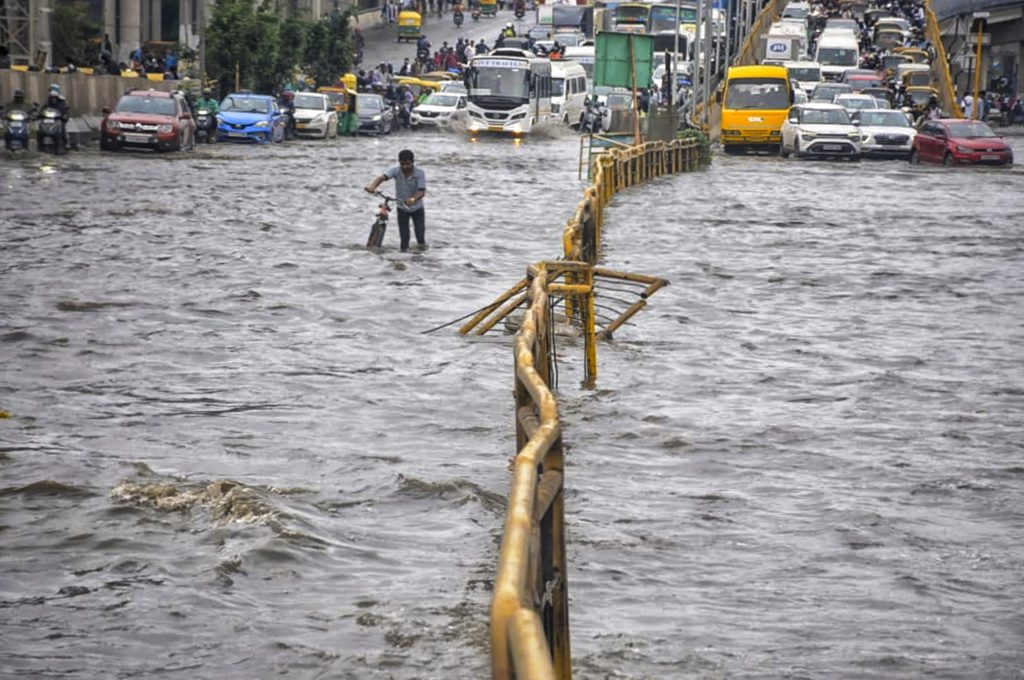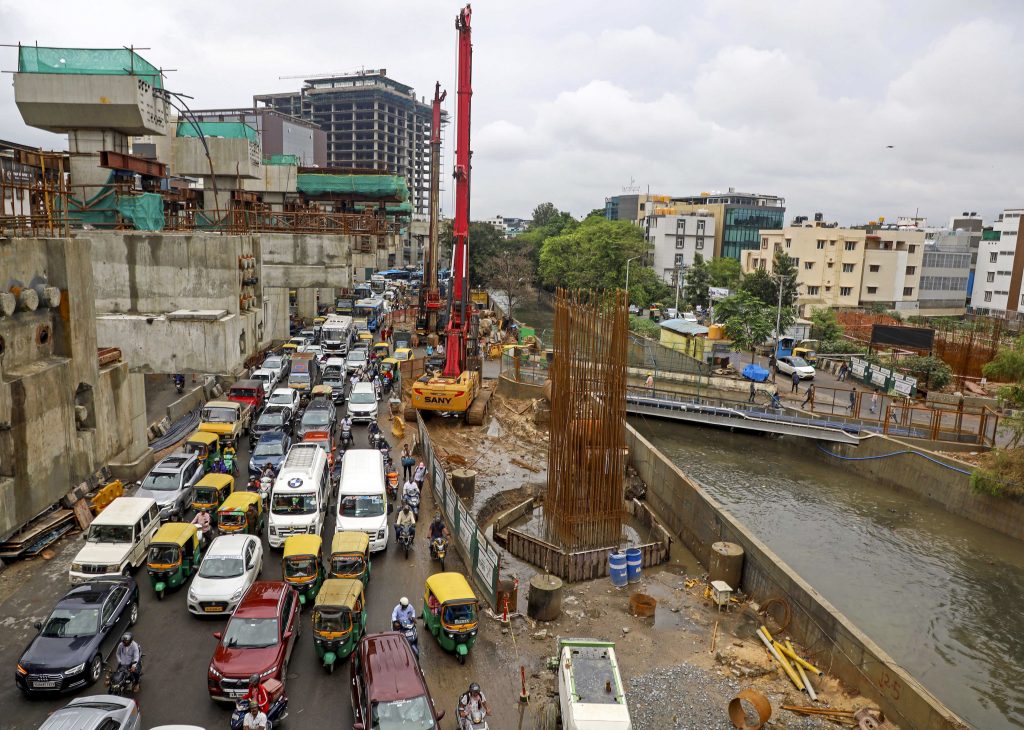Bengaluru Rains Have Returned the Garbage We Carelessly Dumped
Pre-monsoon showers shook Bengaluru overnight last week, with boats taking over waterlogged roads and garbage heaps peeping out of the Rajakaluves, the city's major stormwater drains.
Bengalureans woke up to social media notifications of alarming videos of vehicles wading through submerged roads, flooded neighbourhoods, and passengers falling off their two-wheelers. This has become a recurring exhibit whenever the sky weeps over the city. It reminds Bengaluru of its flawed urban planning and crumbling infrastructure. This year, the morning scene was further enriched by JCBs dredging garbage that choked the Rajakaluves.
Bengaluru has a historic waterway system that interlinks lakes and diverts excess rainwater towards tanks or lakes through channels called Rajakaluves. These massive stormwater drains were designed to regulate the water flow between the lakes during dry and wet seasons. However, recent developments have disregarded and encroached upon these channels by obstructing water flow or discharging domestic and industrial sewage. When the city expanded and the residents no longer relied on these water channels, they became neglected, obsolete gutters where the city's solid and liquid waste is indiscriminately discarded.
Last week, BBMP contractors dredged heaps of solid waste from the clogged drain near the Silk Board junction. This unusual sight appalled many passengers stuck there due to the slow-moving traffic. One might wonder how this hidden waste suddenly popped out and almost immediately put the blame entirely on the BBMP/BSWML, the entities responsible for the city’s waste management. However, multiple stakeholders are involved in the management and maintenance of Rajakaluves, including BBMP, BSWML, KSPCB, KSNMDC, BWSSB and the citizens of Bengaluru.
The Bruhat Bengaluru Mahanagara Palike (BBMP) is the civic body tasked with the construction, maintenance, and remodelling of raja kaluves, as well as preventing and monitoring encroachments. The Bangalore Water Supply and Sewerage Board (BWSSB) handles sewage management, network expansion, and treatment plants, coordinating closely with BBMP. The Karnataka State Natural Disaster Monitoring Centre (KSNDMC) is responsible for validating major drain plans, installing sensors to monitor rainfall, flooding, and choke points, and providing early warnings to the BBMP during heavy rainfall events. The Karnataka State Pollution Control Board (KSPCB) oversees regulatory compliance concerning water, air, and environmental laws, and monitors water quality in drains and lakes. Lastly, the Bangalore Solid Waste Management Limited (BSWML) manages the city's solid waste, which includes preventing the dumping of waste and construction debris into Rajakaluves and their catchment areas.

Bengaluru: Commuters wade through a waterlogged road after heavy rains, in Bengaluru, Tuesday, May 20, 2025. Photo: PTI.
Of course, there has been negligence on their part regarding the proper maintenance of these stormwater drains or any drains for that matter. Nevertheless, the city’s residents are also partners in crime, and we are equally responsible for this crisis.
Actions have consequences, as the saying goes: You reap what you sow. When you litter or covertly dump waste in public spaces – be it on the curbside, in vacant lots, inside drains, or near unfinished flyovers – it doesn't just vanish or evaporate into thin air. It comes back to haunt you when you least expect it, so there's no point in being shocked or blaming the administration. How often have we seen people constructing or renovating homes, with concrete and debris carelessly piled up on the roads next to their sites? A significant portion of this is left behind even after the completion of construction, with most ultimately accumulating in the stormwater drains. You sowed the seeds of wrongdoing, it is time to reap the consequences. Unfortunately, it manifests in its ugliest form, affecting the entire city.
The solid waste management (SWM) issue in the city presents a classic chicken-or-egg dilemma. Residents attribute the problem to the inconsistency of the waste collection system, while the system blames the residents' lack of responsibility. The simple act of source-segregation can unlock the potential for resource recovery from solid waste. When that doesn’t happen, the city's waste often ends up in inconspicuous landfills located near peripheral farmlands, if not in the more visible stormwater drains. People who dump their waste in public spaces often justify their actions by citing the irregularity of the waste collection system. However, this rationale is insufficient to legitimise the pollution of natural resources. Sometimes, people lack the patience to wait for another day if they miss the collection vehicle, and hence, they hastily dispose of their waste elsewhere, in their rush to remove the waste from their homes, even if it means polluting public spaces.

Vehicles stuck in a traffic jam as roads got waterlogged due to heavy rains, in Bengaluru, Tuesday, May 20, 2025. Photo: PTI.
Segregated waste offers solutions even if you miss the collection vehicle or have limited access.
- Clean and segregated dry waste can be stored until collection because it neither stinks nor degrades.
- A big chunk of the sanitary waste can be reduced by switching to a sustainable alternative (cloth napkins, cloth pads, menstrual cups, reusable diapers, etc.).
- Meanwhile, the wet or biodegradable portion of the waste can be composted at any scale if you have the will.
Even if you don't compost, segregating waste reduces the volume of the odorous fraction, allowing you to wait until the next collection day. Hence, the first step in taking responsibility for your waste is by segregating it.
The operation of waste collection and transportation is financially intensive, even without considering the capital investment required for collection and processing systems. The SWM system of the city is currently grappling with a lack of accountability and insufficient infrastructure to cover the entire city. Consequently, it is unsurprising that waste collection in many areas is irregular and inadequate. However, instead of carelessly disposing of your waste, be responsible, ask questions and hold the SWM officials accountable.
If the collection vehicle in your area is inconsistent or misses pickups, inform the Joint Health Inspector or supervisor responsible for monitoring the collection and urge them to take corrective action. Active citizens are essential for an accountable administration.
Established protocols and authorised vendors exist for handling construction and demolition (C&D) waste. Citizens must connect the dots between their carelessly abandoned C&D waste and clogged drains. How often do we enquire the contractor hauling away our C&D waste in a tractor about the disposal location? This waste will likely be dumped in a lakebed or along the edges of a drain.
Therefore, the next time you step out to dump your waste, think of the clogged stormwater drains and waterlogged roads that can complicate your life in the city during the monsoon.
Archana Tripathi is the CEO of Saahas, a non-profit with 23 years of expertise in the solid waste management sector.
Anjali V Raj works in the Knowledge Development and Dissemination vertical at Saahas.
This article went live on May twenty-fifth, two thousand twenty five, at five minutes past two in the afternoon.The Wire is now on WhatsApp. Follow our channel for sharp analysis and opinions on the latest developments.




